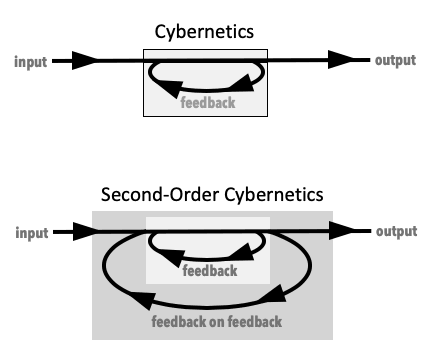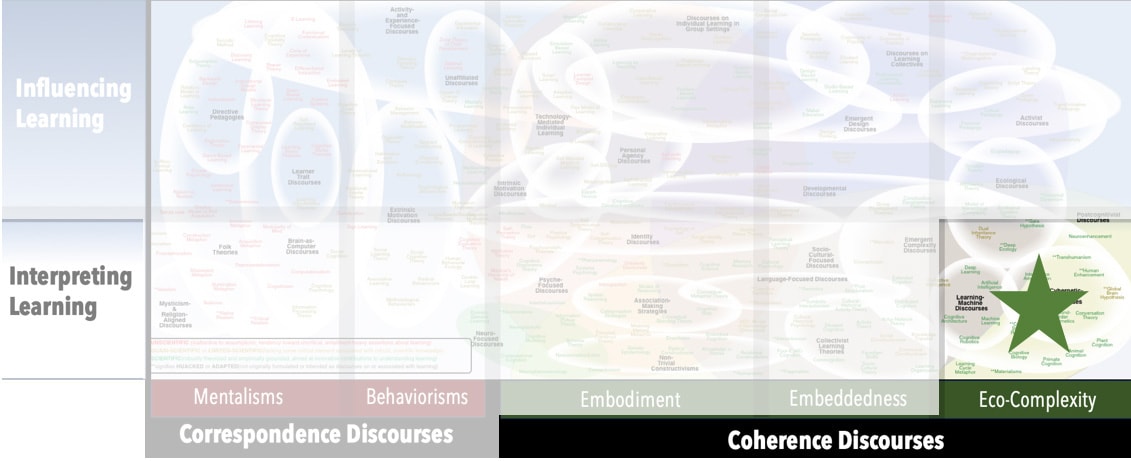AKA
Cybernetics of Cybernetics
New Cybernetics
Second Cybernetics
Focus
Recursively elaborative dynamics among entangled dynamic systemsPrincipal Metaphors
- Knowledge is … current range of functional possibilities
- Knowing is … acting/responding appropriately
- Learner is … adaptive system
- Learning is … adapting, changing
- Teaching is … triggering
Originated
1960sSynopsis
Three popularly cited characterizations of Second-Order Cybernetics are:
- the Cybernetics of Cybernetics (i.e., the recursive application of Cybernetics to itself)
- the study of Cybernetics by people who recognize themselves to be part of the system they’re studying (or, the realization that there are no observerless observations)
- the study of organism-plus-environment as a single system
- Self-Reference – any instance of a system, rule, or discourse referring to itself. The concept is also invoked in mathematics, philosophy, systems thinking, computer programming, linguistics, and consciousness studies. Within Second-Order Cybernetics, Self-Reference is understood as recursive and as a necessary criterion for learning systems.
- Artificial Life (Christopher Langdon, 1980s) – the study of life processes and the attempt to recreate aspects of biological phenomena through computer, robotic, and biochemical simulations – which, among other things, has demonstrated that “living” and “learning” are not dissociated processes
- Generativity (Technological Generativity; Theory of Generativity; Theory of Technological Generativity) (Jonathan Zittrain, 2000s) – extending the notion of “generativity” from Psychosocial Development Theory, a perspective on how technology systems create (or might be enabled to create) behaviors, outputs, or structures that were not anticipated or intended by the system’s designers
- Sociocybernetics (Felix Geyer, 1990s) – a blend of Sociology and Complex Systems Research that embraces the insights of Second-Order Cybernetics. Sociocybernetics focuses on cooperative behavior.
- Xenobots (Biobots) (Douglas Blackiston, 2020s) – synthetic, programmable lifeforms that are composed of biological tissues and designed to perform specific functions. Some are self-replicating. The technology is evolving quickly. Subtypes include:
- Anthrobots (2020s) – a type of Xenobot derived from human cells
Commentary
Almost entirely, criticisms of Second-Order Cybernetics are based on either shallow readings or troublesome descriptions/applications.Authors and/or Prominent Influences
Margaret Mead; Gregory Bateson; Heinz von Foerster; Gordon PaskStatus as a Theory of Learning
As with Cybernetics, it is more correct to say that Second-Order Cybernetics offers a theory of learning than Second-Order Cybernetics is a theory of learning. The domain is too broad to constrain it to one focus – even when that focus is as expansive as “learning.”Status as a Theory of Teaching
Second-Order Cybernetics is not a theory of teaching.Status as a Scientific Theory
Second-Order Cybernetics easily meets our criteria for a scientific theory.Subdiscourses:
- Anthrobots
- Artificial Life
- Self-Reference
- Sociocybernetics
- Xenobots (Biobots)
Map Location

Please cite this article as:
Davis, B., & Francis, K. (2025). “Second-Order Cybernetics” in Discourses on Learning in Education. https://learningdiscourses.com.
⇦ Back to Map
⇦ Back to List
